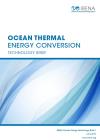

Ocean Thermal Energy Conversion: Technology Brief
Newsletter
Ocean Thermal Energy Conversion (OTEC) power generation makes use of temperature differences between upper surface layer and deeper layers (800 –1000 m) of the sea, generally operating with temperature differences of around 20°C or more.
The advantages of OTEC include being able to provide electricity on a continuous (non-intermittent) basis, while also providing cooling without electricity consumption. The technological challenge is that the small temperature difference requires very large volumes of water at minimum pressure losses. This requires large seawater pumps, large piping systems, and large cold water pipes operating almost continuously in a hostile and corrosive environment. OTEC seems especially suitable and economically viable for remote islands in tropical seas where generation can be combined with other functions e.g., air-conditioning and fresh water production.
Recent studies suggest that total worldwide power generation capacity could be supplied by OTEC, and that this would have no impact on the ocean’s temperature profiles.
This brief forms part of a set by the International Renewable Energy Agency (IRENA) covering four main types of ocean energy technologies: Ocean Thermal, Tidal, Wave and Salinity Gradient energy.
Successive technology briefs have highlighted a wide range of renewable energy solutions. Each brief outlines technical aspects, costs, market potential and barriers, combined with insights for policy makers on how to accelerate the transition to renewables.




